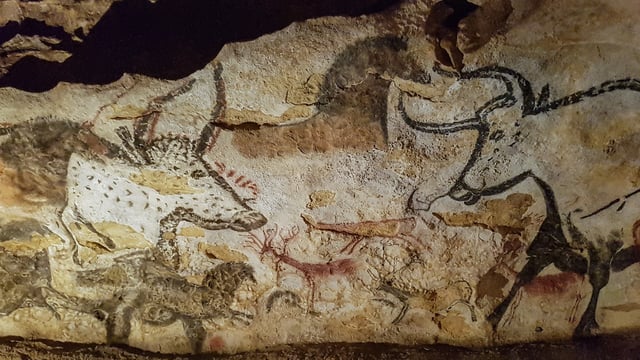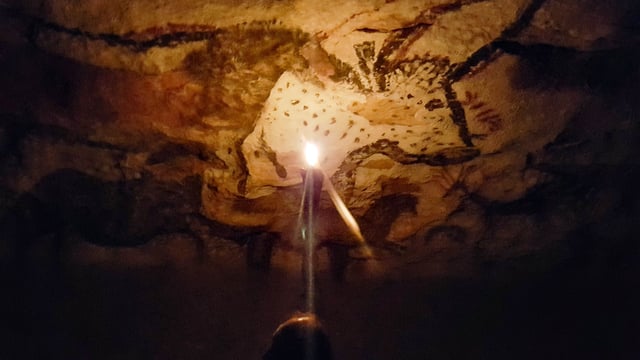If you are planning a trip to Europe to visit some of the spectacular caves with Ice Age art, or perhaps you have recently been and would like to know more, Cave Art by Jean Clottes is just what you are looking for. This is not a photographic celebration of some of the best known prehistoric art in Europe, it is an ‘imaginary museum’ that offers an accessible, guided tour of prehistoric art in Europe made between about 35 000 and 11 000 years ago. And, under Jean Clottes’ guidance you could not be on safer, less fantastical ground, for I am certain it is true that no single rock art scholar has seen more rock art around the World than he.
- Thomas Dowson
- Last Checked and/or Updated 11 February 2023
- No Comments
- Reviews
Cave Art is published by Phaidon – a publishing house well known for its large format art books. In 1936 monographs with high quality reproductions of art by the likes of Van Gogh and the French Impressionists were amongst the earliest affordable yet sumptuously illustrated art books to be published. Since then Phaidon has become the World’s leader in publishing high quality, affordable art books. And it is this experience that is so evident; Cave Art is a beautiful book in its own right.
English editions of Cave Art are available in both hardcover and paperback; the French edition is, however, only available in paperback. It is a large format book, 29 x 25 cm, therefore allowing for wonderful double-page spreads of some truly breathtaking photographs. Clottes has gathered together a fine collection of photographs, some of which he has taken himself. And with 340 pages there are many of these – in all, 275 richly reproduced colour illustrations. Given such a large book, in its format and number of pages, if this is a book you are going to use repeatedly I would certainly recommend the hardcover edition.
An Imaginary Museum
As big as the book is, illustrating and discussing each and every example of Palaeolithic imagery in Europe is simply impossible. Inevitably then Clottes has had to make some hard choices about what to include and what to exclude. In providing the comprehensive overview of Palaeolithic wall art in Europe that you get from this book, it has been at the expense of portable art – the small statuettes and figurines carve in bone, stone and ivory, the incised images on stone, bone and antlers. While these are not absent, they are understandably, and rightly, not prominent in this book. This book is about the 20 – 25 000 Palaeolithic years of wall art in the caves and shelters of Europe.
Clottes has created what he calls an “imaginary museum”. What I think is particularly innovative is the way in which the caves and their images have been divided into three periods of image making, each associated with an emblematic, and iconic, cave. These three caves are widely known, and have been influential in creating both academic and popular understandings of Palaeolithic cave art. The three are Chauvet which covers 35 000 to 22 000 year ago, Lascaux and the period from 22 000 to 17 000, and finally Niaux from 17 000 to 11 000.
Each illustration is juxtaposed with engaging and very readable captions. These captions tell of the discovery of the caves, the importance of the cave, as well as the significance of the imagery for cave art research. And although each caption can be read on its own, as if you were wondering through a museum selectively reading labels, read together from start to finish you get an idea of how it is we come to know something of the imagery form that period. Obviously the length of the captions vary from image to image, and the number of photographs representing each site varies. But if there is anyone who is in a position to make a choice about what to include and what to exclude it is Jean Clottes. Not only has he captured the striking uniformity of Palaeolithic wall art, but he has also managed to convey its diversity and how it may have changed through time.
All the sites that are open to the public are included in the book, even if it is not every image you will see. But, because the sites are set within the context of our current understanding of the chronological development of this tradition of image making, this book provides an excellent source for visitors to sites to then explore Palaeolithic cave art further from the sites they have visited and the imagery experienced there.
Cave Art is as interesting to read as it is beautiful to hold.
Europe and Beyond
The focus of the book is the cave art of Europe, western Europe. There is also a final section that illustrates Palaeolithic art created after 11 000 years ago and located elsewhere in Europe and the World, to demonstrate that the making of art did not stop at the end of the Ice Age and was not restricted to western Europe. For me, this is the least successful element of the book. While it is true some readers will need to be reminded, some even informed perhaps, that art was created by hunter gathering peoples after the Ice Age ended and in areas other than France and Spain, we should not forget the reasons why reminders such as these are necessary.
For decades we have been fed a decidedly Eurocentric approach to the history of art. Somewhat ironically, this is best seen in another very successful book also published by Phaidon: Ernst Gombrich’s The Story of Art. In Gombrich’s book the history of art begins in Europe and culminates in the traditions of western Europe – from Lascaux to the Louvre. Many people know about Lascaux and Chauvet, and yet they often do not know that there exist as important traditions of prehistoric art in their own countries.
Clottes is right to remind readers of these other traditions. I am not convinced, however, that the place of these – effectively at the end of the book – will do much to challenge Eurocentric approaches to the stories of World art. For instance, some of the traditions included in the final section, the traditions are as long, and may even be longer than the 25 000 years of European cave art. Some of these, for example from southern Africa, are older than 11 000 years. I would have been very happy to see Clottes’ presentation of the great cave art of Europe celebrated for what it is.
Although Cave Art is a guide through some 80 odd sites in Europe, with very interesting information about the caves, their history and the imagery you will see (certainly in those that are accessible), this is probably not the book you will want to lug around with you on your tour of the caves. It is just so big, and beautiful. And given the price of the hardback edition (it is understandably not cheap) you probably will not want to be throwing that around a rucksack or the back of a car. Unless of course you get the paperback and do not mind extra weight and what the book will look like at the end of your travels. It is the book you will want to read before you go, and/or after your trip. Cave Art is the perfect book for preparing your visit to these caves, and on your return it will be as engrossing for a long time.
On Amazon.com: Cave Art by Jean Clottes (hardcover), (also available in paperback)
On Amazon.co.uk: Cave Art by Jean Clottes (paper), (also available in hardcover)






